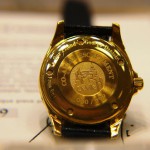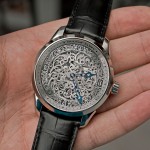Insight: Daniels’ Co-Axial Escapement, an Evolution of the Fasoldt Chronometer
Inspired by a 19th century invention.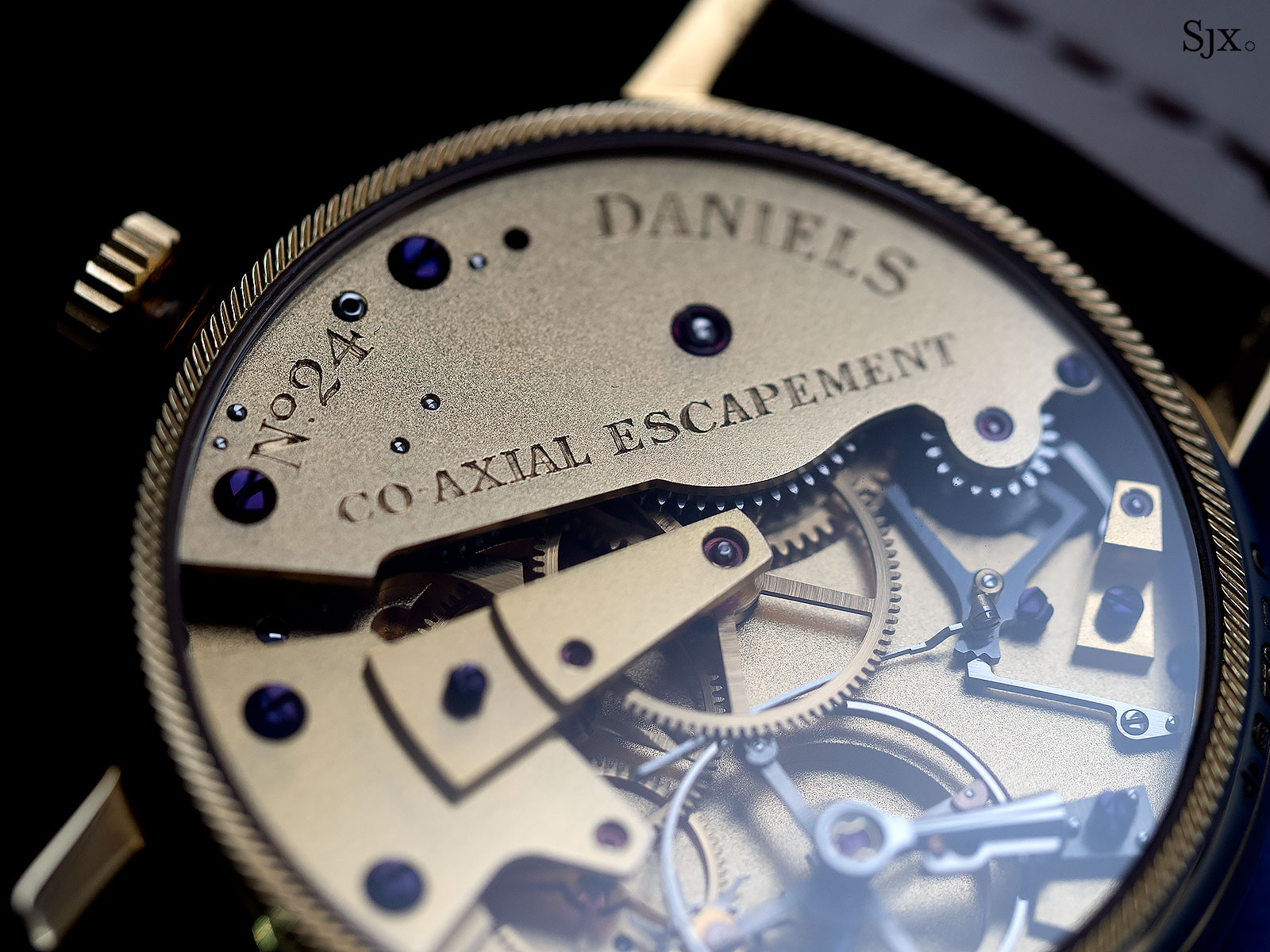
In the quest for precision chronometry in a mechanical watch, perhaps no other component is as crucial as the escapement – often consisting of an escape wheel and lever that engage with the oscillating organ. The history of watchmaking recounts many an attempt at inventing a better-performing escapement, with some attempts naturally more successful than others.
By the 20th century, the watch industry had settled upon the Swiss lever escapement, which has proven itself to be a reasonably solid performer and crucially, one fit for mass production. However, in the latter decades of the century, one English watchmaker attempted to challenge the industry status quo. In 1974, George Daniels invented the “co-axial escapement”, a seemingly novel and practical escapement of his own design that was conceived as an functionally superior alternative to the Swiss lever escapement. Daniels’ invention fulfilled his ambition, at least in part, when it was sold to Omega and then successfully industrialised starting in 1999; today it is found in hundreds of thousands of movements that Omega produces each year.
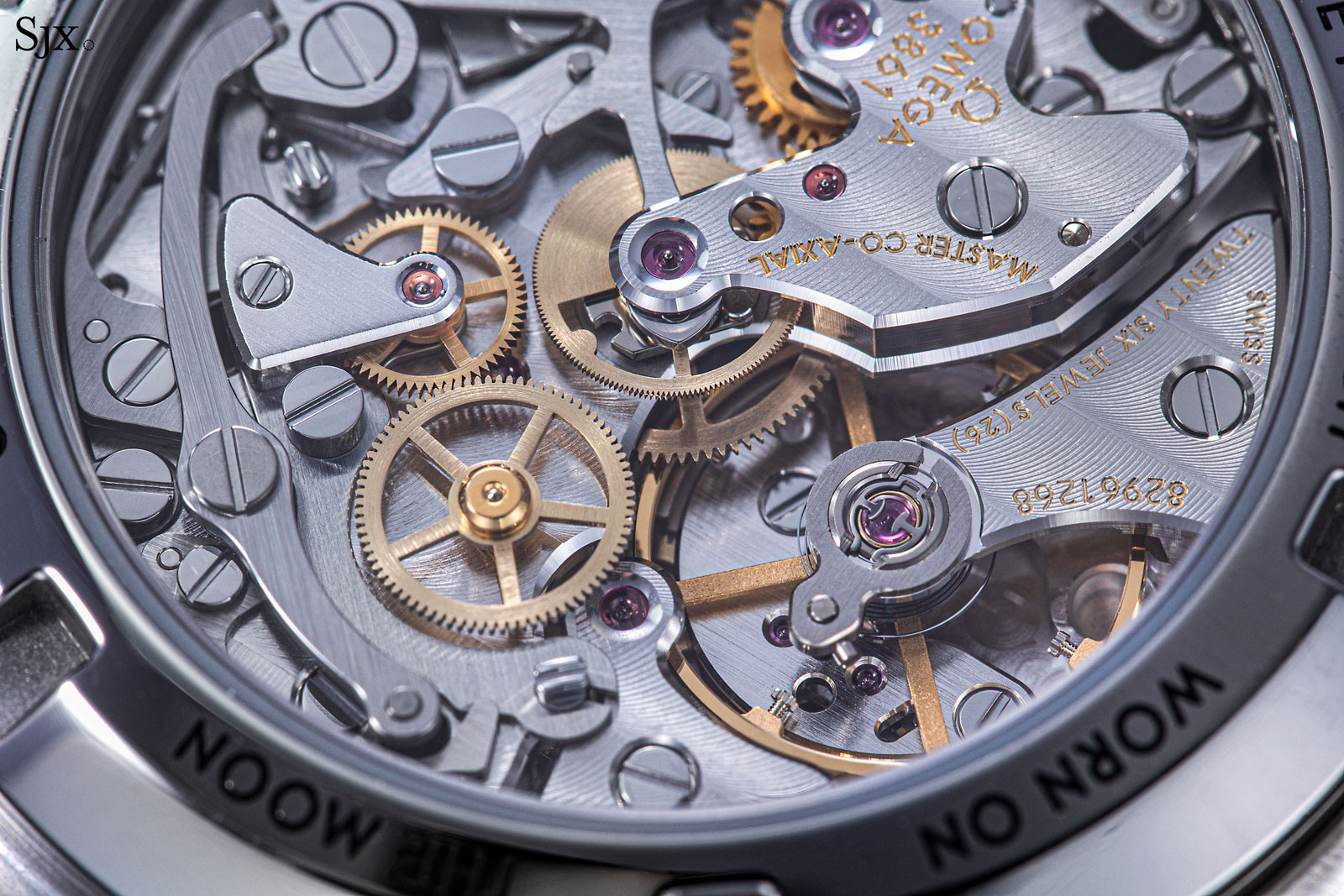
The latest iteration of the Omega Speedmaster Moonwatch is kitted out with the co-axial escapement
With the merits of the co-axial escapement having been proven in part by its large-scale adoption, my aim here is not to examine its intrinsic qualities, but rather delve into its development. Specifically I will explore the fact that the co-axial escapement might not be an entirely new design, but rather a surprisingly direct evolution from one of history’s more obscure escapements, the Fasoldt chronometer escapement, which dates to the early 1860s.
Solving an age-old problem, from Breguet to Daniels
Put simply, any mechanical timekeeper requires an escapement to regulate the energy discharged by the mainspring. An escapement operates like a stepper mechanism: the escapement locks and unlocks the gear train’s movement at a set pace. Most escapements consist of an escape wheel that’s blocked by a lever and released periodically by an oscillating balance wheel affixed to a coiled hairspring.
Driven by the mainspring and its associated going train, the escape wheel powers – directly or indirectly – the oscillating motion of the balance wheel. It can thus be concluded that the escapement performs two functions at the same time: it determines the rate of mainspring discharge while maintaining the oscillations of the balance wheel.
For the last century, the watch industry has relied almost exclusively on the Swiss lever escapement to keep its watches ticking. While being relatively easy to produce and adjust in mass production, the Swiss lever escapement relies on a generous sliding action that delivers an indirect impulse to the balance.
This sliding motion creates sliding friction, which tends to degrade a moving part relatively quickly. In a Swiss lever escapement, the moving parts subjected to sliding friction are the jewel pallets of the lever and the teeth of the escape wheel. But for optimum performance, the friction coefficient between the two sliding surfaces should be minimal. The natural and most widely embraced solution to is to protect such surfaces with another substance that acts a buffer. Various lubricants are thus used for the escapement, ever since the invention of the clock.
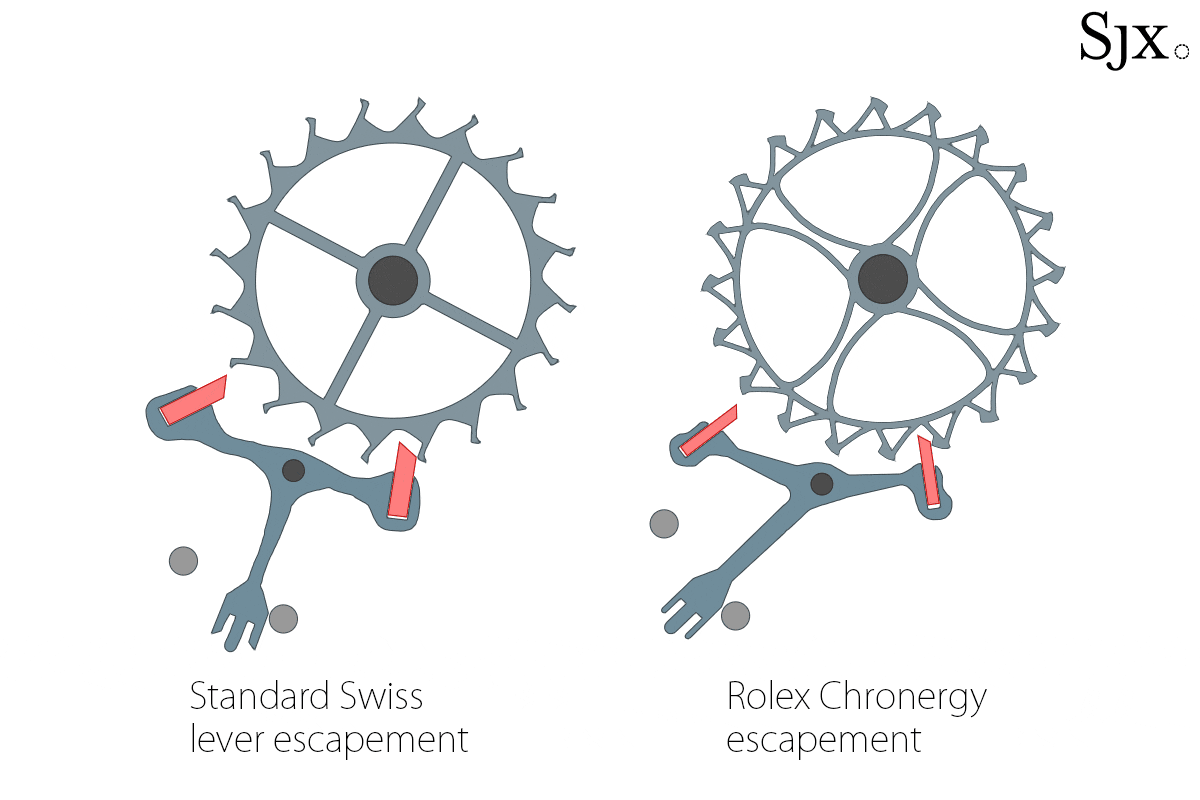
Two examples of the Swiss lever escapement that both function on the same mechanical principles: the back and forth swing of the pallet lever locks and unlocks the gear train
Lubricants, however, deteriorate over time. The synthetic lubricants in use today are more long-lasting than the natural oils used in Abraham-Louis Breguet’s time that tended to clump up, resulting in them acting counter to their intended purpose and causing premature wear to the movement. But even in modern watchmaking the best lubricants don’t last forever, so a perfect escapement would require either an everlasting oil or simply eliminating lubricants altogether in a “dry” escapement that would not require lubrication by design. Being a watchmaker rather than a chemist, Daniels naturally chose the latter solution in his quest for the perfect escapement.
For almost two centuries, the oil-less escapement of choice in high grade chronometers was the detent escapement, also known as a chronometer escapement due to its preferred use in top-grade timepieces. While too fragile and unreliable for use in wristwatches, the detent escapement personified the purest concept of the escapement as it functions by providing direct impulse to the balance wheel in a virtually frictionless manner, with the slightest tangential push. In other words, the detent escapement doesn’t create sliding friction in its operation.
But the major shortcoming of the detent escapement is the fact that the impulse is provided in a single direction, once per oscillation in other words, as opposed to twice per oscillation with each alternation of the balance in a lever escapement. As a result, the detent escapement isn’t self-starting by design. As a result, should the balance be stopped, either accidentally or with intent, a detent escapement cannot not start again on its own and the timepiece requires gently shaking to initiate oscillation of the balance.
Moreover, the detent piece stopping the escape wheel can be easily disturbed by shocks, leading to premature unlocking of the escape wheel. Incidentally, the escapement’s name is derived from this device that detains the escape wheel (detent is French for “detain”) during the balance wheel’s supplementary arc. Generally, safety rollers can’t be employed in such an escapement, allowing for no meaningful solution to these problems.
Daniels used the detent escapement in his early pocket watches, but recognised the weaknesses that made it unsuitable for wider use, especially in wristwatches. To this day, the detent escapement has never been successfully adopted for large-scale production and remains an esoteric feature found in more artisanal watches.
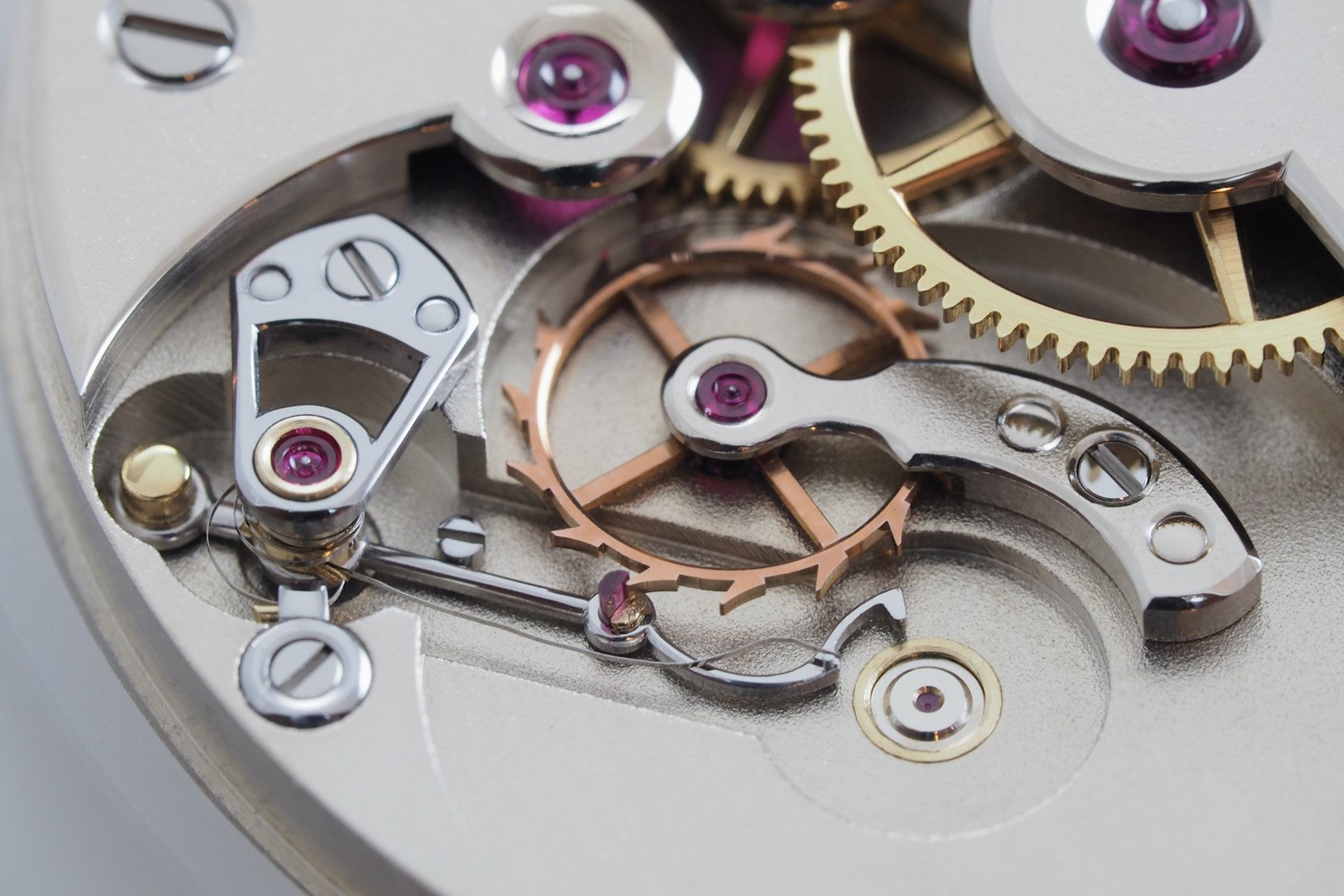
The detent escapement found in Raul Pages RP1, one such artisanal watch. Image – Raul Pages
At the request of a client who commissioned a watch with an “extraordinary escapement”, Daniels turned to his experience as a Breguet scholar and drew inspiration from one of Breguet’s less-known (at the time) inventions, the échappement naturel, or “natural escapement”.
Breguet’s natural escapement involved two detent-like escape wheels arranged in a mirrored layout, both governed by a pivoted detent. Each escape wheel was made up of two layers, one the actual escape wheel with ratchet-like teeth and just below anther gear with a larger circumference.
The two escape wheel assemblies were joined through the meshing of their lower, wider gears. One of the escape wheels also featured a traditional escape pinion that engaged the rest of the gear train. Driven by the mainspring, the first escape wheel engaged the second, which spun at an a speed theoretically equal to the speed of the first.
For clarity, I present F.P. Journe’s patent for its own natural escapement, a modern, yet highly faithful, take on the échappement naturel. In fig. 1 we can observe the two large escape wheels, each with its own wider driving gear underneath (marked 2 and 3 in the drawing).
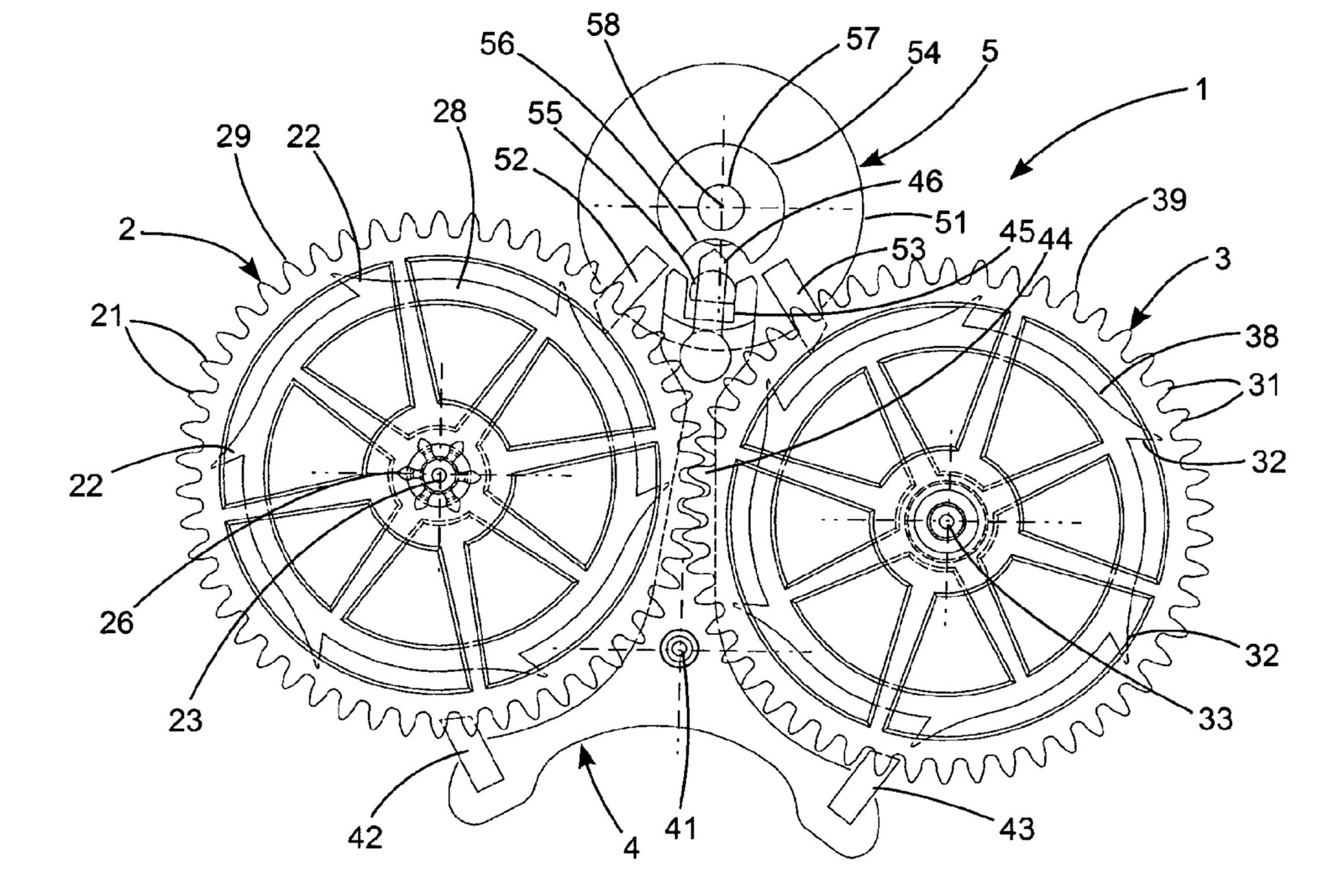
Fig. 1: A modern interpretation of Breguet’s natural escapement that is surprisingly close to the original in execution. Image – Patent EP 2 487 546 A1, Montres Journe SA
Breguet’s invention was essentially an escapement that impulsed the balance wheel in the same advantageous manner as the detent escapement – without sliding friction – but it did so twice an oscillation, with each escape wheel delivering an impulse once an alternation.
The main issues with Breguet’s natural escapement lay in the gearing that drove the second escape wheel. By design, when the primary escape wheel was locked by the detent, the second was free of any load and under no tension from the barrel. This, in conjunction with imperfect teeth profiles resulted in play within the meshing of the second escape wheel.
This unwanted radial play caused energy loss as well as unequal impulses. Equally, the friction generated between the two meshing gears proved to be substantial. Add to that the inertial losses caused by the second escape wheel with play in its meshing, the efficiency gains of the escapement design were in practice overcome by the limits of manufacturing at the time. Even after a number of tweaks, Breguet eventually dropped the idea altogether and shifted his focus to the lever escapement.
Over a century later, Daniels solved the problems faced by Breguet by removing the meshing gears between the twin escape wheels, thus rendering them independent (fig. 2). He linked the second escape wheel to a secondary gear train that mirrored the first. The two gear trains converged near the balance wheel and were synchronised by a type of pivoted detent that alternately locked and unlocked each escape wheel, effectively acting on both escape wheels.
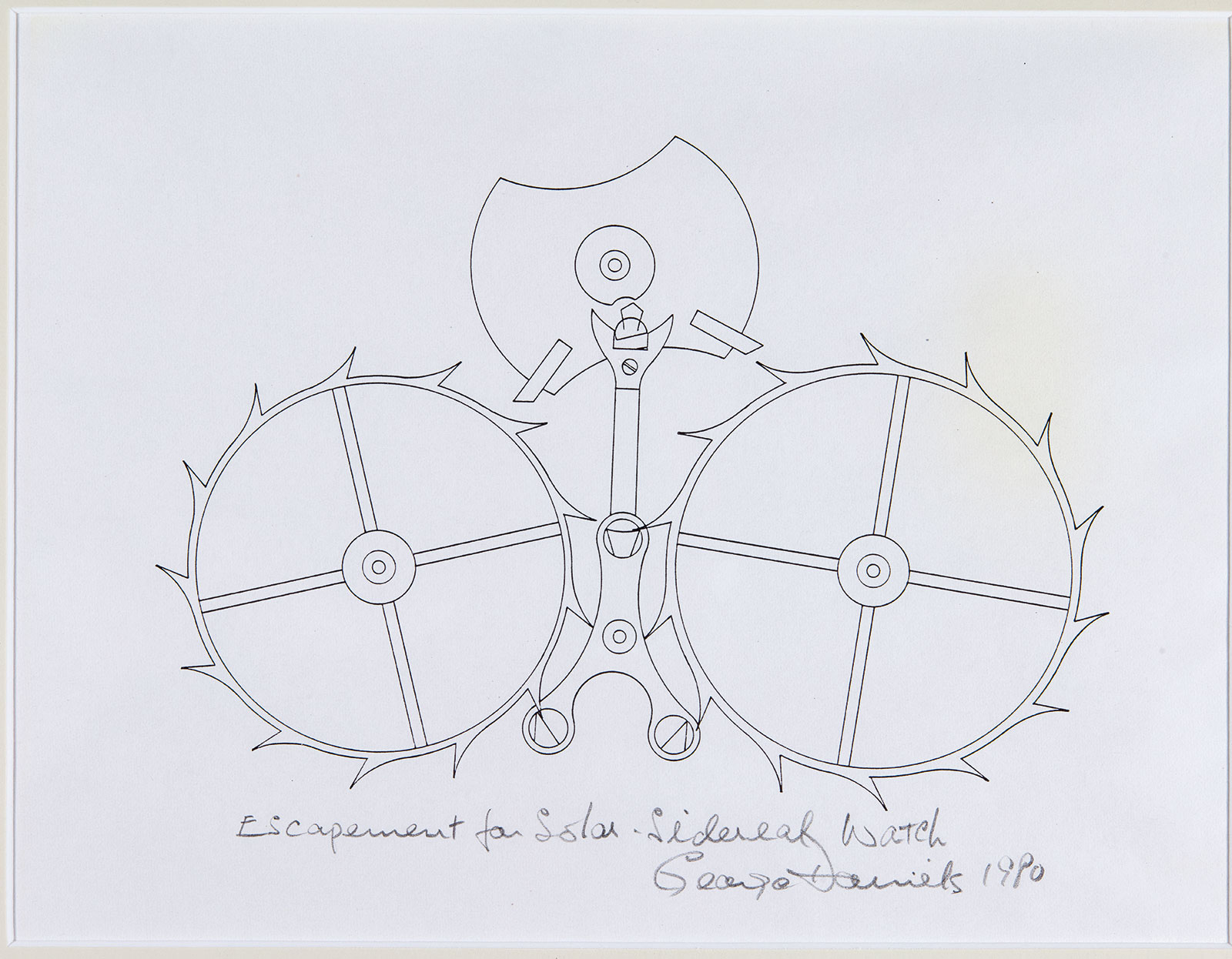
Fig. 2: A 1990 sketch showing the final iteration of Daniels’ double-wheel escapement. Image – Sotheby’s
The result was his double-wheel escapement – most famously found in the Space Traveller pocket watch – that delivered highly satisfactory timekeeping. Daniels himself recounted in his memoirs a timepiece equipped with this escapement deviated by a mere second over the course of one month.
The merits of Breguet’s natural escapement meant that Daniels was not the only watchmaker to build on the idea. In the 21st century it has been taken even further thanks to modern technology, Ulysse Nardin for instance was the first watchmaker to use silicon in a mechanical movement in the form of twin silicon escape wheels.
While he was pleased with his feat, Daniels didn’t further develop the independent double-wheel escapement because he knew it was difficult, if not impossible, for the design to be produced on a large scale. But the experience he gained while tinkering with the natural escapement seemed to have left a lasting impression on him. It was undoubtedly here that Daniels observed first-hand the superior performance of a low-friction, double-impulse escapement in real-life testing. Unsurprisingly, he would go on to retain almost exactly the same balance roller design in the co-axial, but with only one impulse pallet instead of two.
Fasoldt’s way
Born in the German city of Dresden, Charles Fasoldt (1819 – 1889) was watch- and clockmaker who emigrated to America and eventually set up shop in Albany, New York. He preoccupied himself with a diversity of timekeepers ranging from tower clocks to precision pocket chronometers. Among other things, he is credited with inventing a large clock escapement and a smaller escapement for use in pocket watches.
But it is his invention described in American patent no. 46’652 dated March 7, 1865 that is most significant. Simply titled “C. Fasoldt, Chronometer”, it speaks of a “new and Improved Escapement for Chronometers”. The patent further details the escapement with four drawings, three of which show the escapement in the different stages of impulsing and locking (fig. 3).
Fasoldt’s escapement is composed of two escape wheels mounted co-axially, a three-pallet lever, and a balance roller. The lever is held in place by a jewelled, finger bridge and banks on two pins, in a manner similar to that in a conventional Swiss lever escapement. Although the patent drawings omit the safety roller and pin stemming from the fork, Fasoldt’s escapement was equipped with both.
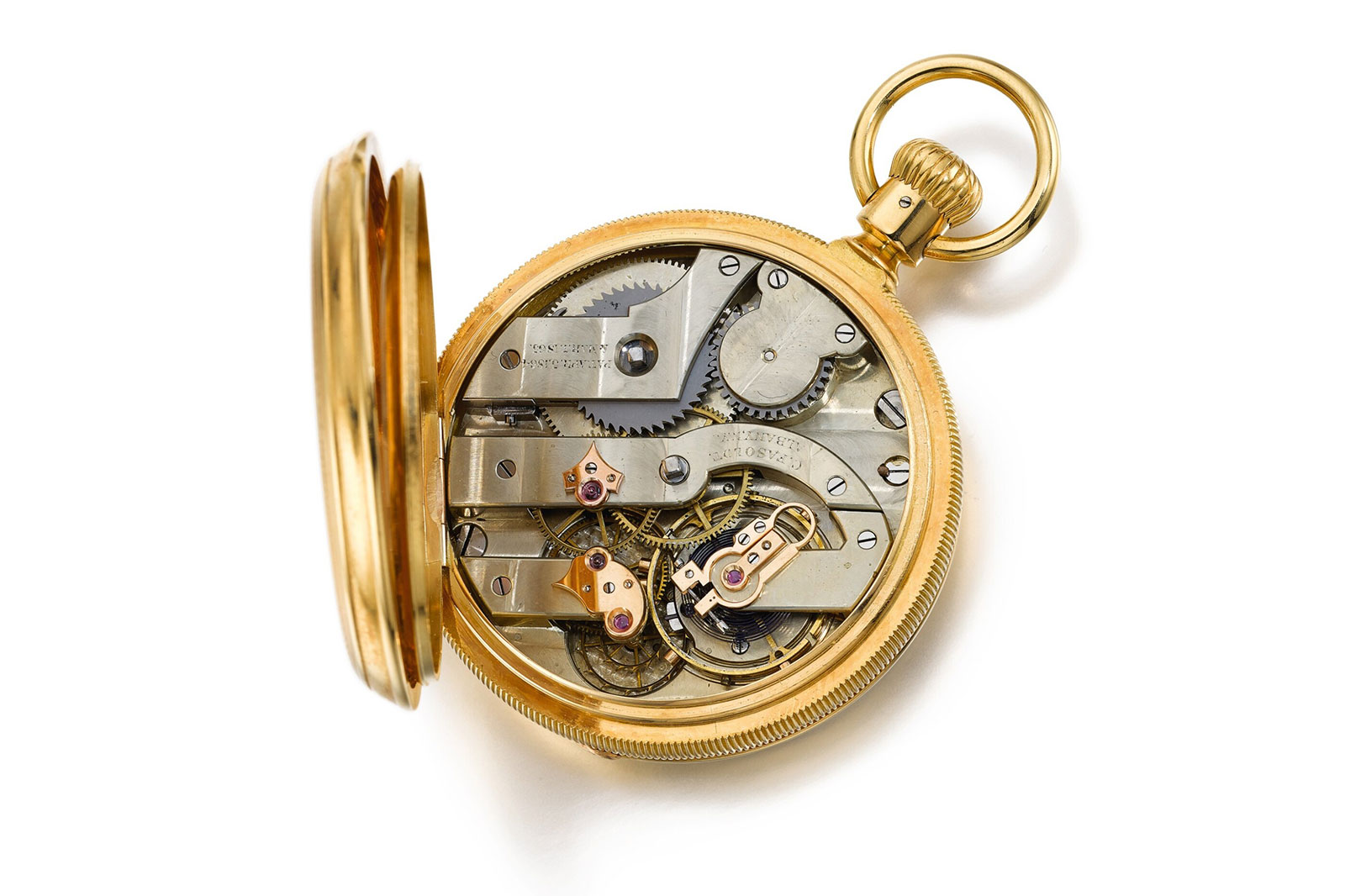
A Charles Fasoldt pocket watch no. 353 from 1870 featuring his patented double wheel chronometer escapement that sold at Sotheby’s in 2019. Image – Sotheby’s
Notably, Fasoldt’s invention is also a type of duplex escapement – the Fasoldt escapement was among the first to incorporate twin, stacked escape wheels mounted co-axially, and he was most certainly the first to have used a three-pallet lever.
Invented in the early 18th entry, the aforementioned duplex escapement was the first to feature an escape wheel with two levels of teeth. Some iterations of the duplex escapement replaced one wheel with raised pillars in an effort to lower the unwanted inertia. Curiously, the latest iteration of the co-axial escapement developed by Daniels’ protege Roger W. Smith’s makes use of the same artifice, replacing one escape wheel with pillars, resulting in a co-axial escapement with a single escape wheel.
While satisfactory for its era, the duplex escapement is not effective or reliable because it relies heavily on prolonged direct contact with the balance arbour, which leads to frictional rest. Despite not the most excellent of timekeepers, the duplex escapement was the first to propose a two-level escape wheel, which is a key feature of Fasoldt’s escapement.
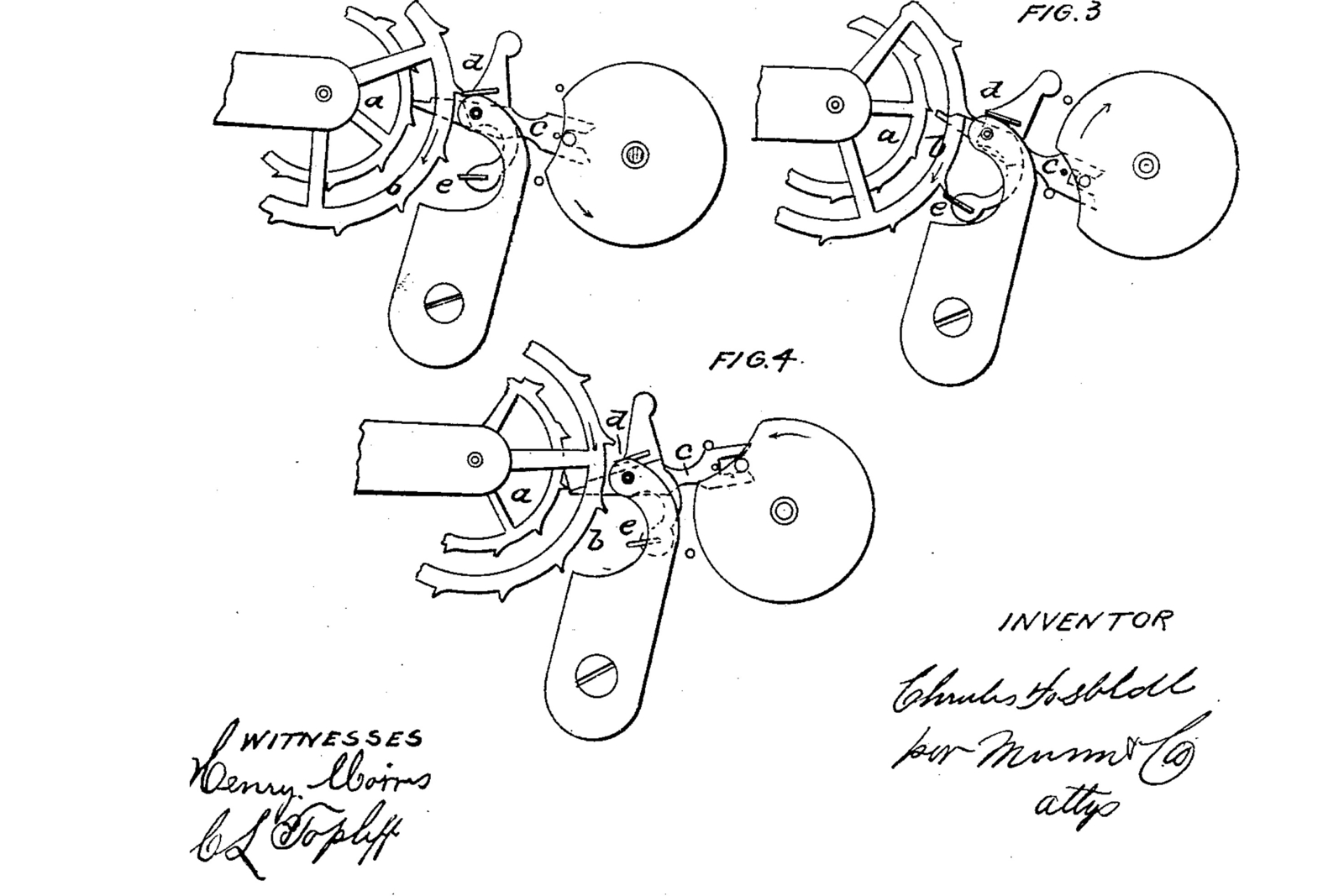
Fig. 3: The drawings of Fasoldt’s escapement. Image – US patent 46’652, C. Fasoldt
While Fasoldt labelled his invention a chronometer escapement, it is distinctly not a detent escapement, rather it is a double-wheel escapement.
Its functioning is fairly straightforward: note how one locking pallet (d in fig. 3) is decidedly closer to the lever’s fulcrum. This results in it having a deeper penetration accomplished by the same arc as for pallet e. Due to deeper-than-desired angular penetration of d, some light sliding may occur, but not nearly as severe as in the Swiss lever.
The desired effect of such geometry is a slower unlocking followed by a comparatively fast locking, which further results in an infinitesimal advance of the escape wheel when pallet d unlocks and pallet e locks. This particular arrangement and function resembles that of the Robin escapement devised by French watchmaker Robert Robin in the 18th century.
While it may not seem particularly noteworthy at first, there’s a small detail that will prove important later: due to the indirect impulse by means of the lever, the balance wheel is impulsed only when its direction of rotation is the same as that of the escape wheel. The reasoning behind this is rather simple: the assortment (escape wheel, lever and balance wheel) functions like an odd number of meshing gears (during the brief period when the escape wheel engages the balance through the lever), in which case the last gear (in this case the balance wheel) rotates in the same direction as the first (the escape wheel).
That happens because the lever assumes the role of an intermediate wheel, passing force indirectly between the escape wheel and balance. In a direct-impulse escapement it happens precisely the other way around, the impulse is given when the balance wheel swings in the opposite direction of the escape wheel’s motion, a movement akin to that of an even number of gears.
Assuming the mainspring and gear train coerce the escape wheel into moving in a clockwise direction and that at a given moment the balance wheel swings clockwise, the Fasoldt’s escapement functions as follows: while the balance is currently completing a supplementary arc after just having been impulsed, the escape wheel remains locked by means of pallet d. When the hairspring’s resisting force overcomes the impulse’s momentum, the balance swings back in a counterclockwise manner and its pin engages with the lever c’s fork and drags it from one banking pin to the other. On the other side of the fulcrum point, pallet d retracts from escape wheel b’s tooth slow enough for the pallet e to catch another tooth almost instantly after pallet d clears the escape wheel for moving.
Both escape wheels have moved by a small arc, which sets escape wheel a’s tooth in position and ready to drop into the impulsing pallet of the lever. Exiting the engagement with the lever c, the balance wheel continues its counterclockwise motion, driven by its own momentum. When said momentum becomes overcome by the hairspring’s resistance, it again changes direction, assuming a clockwise direction. The balance pin yet again comes in contact with the lever c’s fork, dragging it counterclockwise from one banking pin to another, which causes pallet e to disengage with escape wheel b and pallet d to fall right behind the tooth it used to lock in the previous phase, which gives escape wheel b the freedom to rotate a distance equal to the one between two of its teeth.
Moving at the same time with wheel b, one of wheel a’s teeth drops onto the impulsing pallet, pushing it, pallet which in turn passes the received impulse through the lever and to the balance wheel. Escape wheel b locks into pallet d and stops, while the impulsed balance accelerates clockwise. This succession of events happens with regularity until the mainspring’s power runs down.
Evidently, by being a single-beat escapement, the Fasoldt is not self-starting. As was the case with the detent escapement, the Fasoldt would require a gentle shake in order to initiate oscillation.
The escaping or lift angle is not specified, but satisfyingly accurate conclusions can be drawn from Fasoldt’s sketches – the lift angle has an approximate value of 62°. The circumferential ratio between lever and balance is 1.2:1, which makes for approximately 52° lever angle. These values suggest a decreased efficiency of the escapement caused by a prolonged engagement between the lever and the balance.
While neither Fasoldt nor his escapement ever gained fame (though his watchmaking business was modestly successful), his take on a chronometrically-capable escapement has its merits. The impulse is delivered in a radial, albeit indirect manner, the tangential contact during the drop causing only a small amount of resting friction as opposed to the sliding friction in Swiss lever escapements. The theoretical absence of any sliding action means there is no practical need for oiling, since the risks of congealed lubricants would far outweigh any theoretical benefits.
Fasoldt concluded his patent with what we can only assume are his observations after having experimented with running his escapement in various way: “No oil is required to make the escapement work smooth, and the injurious effects of such use are not felt. The watch keeps correct time as well after it has been in use for years as it does when new, and it is not affected by counter motion or sudden jars.”
He was obviously very confident in his creation for he equipped almost all of his pocket watches with the escapement. In terms of materials used, Fasoldt crafted the two co-axial escape wheels in gold and the lever in either steel or gold, which was customary for high-quality watches during the period.
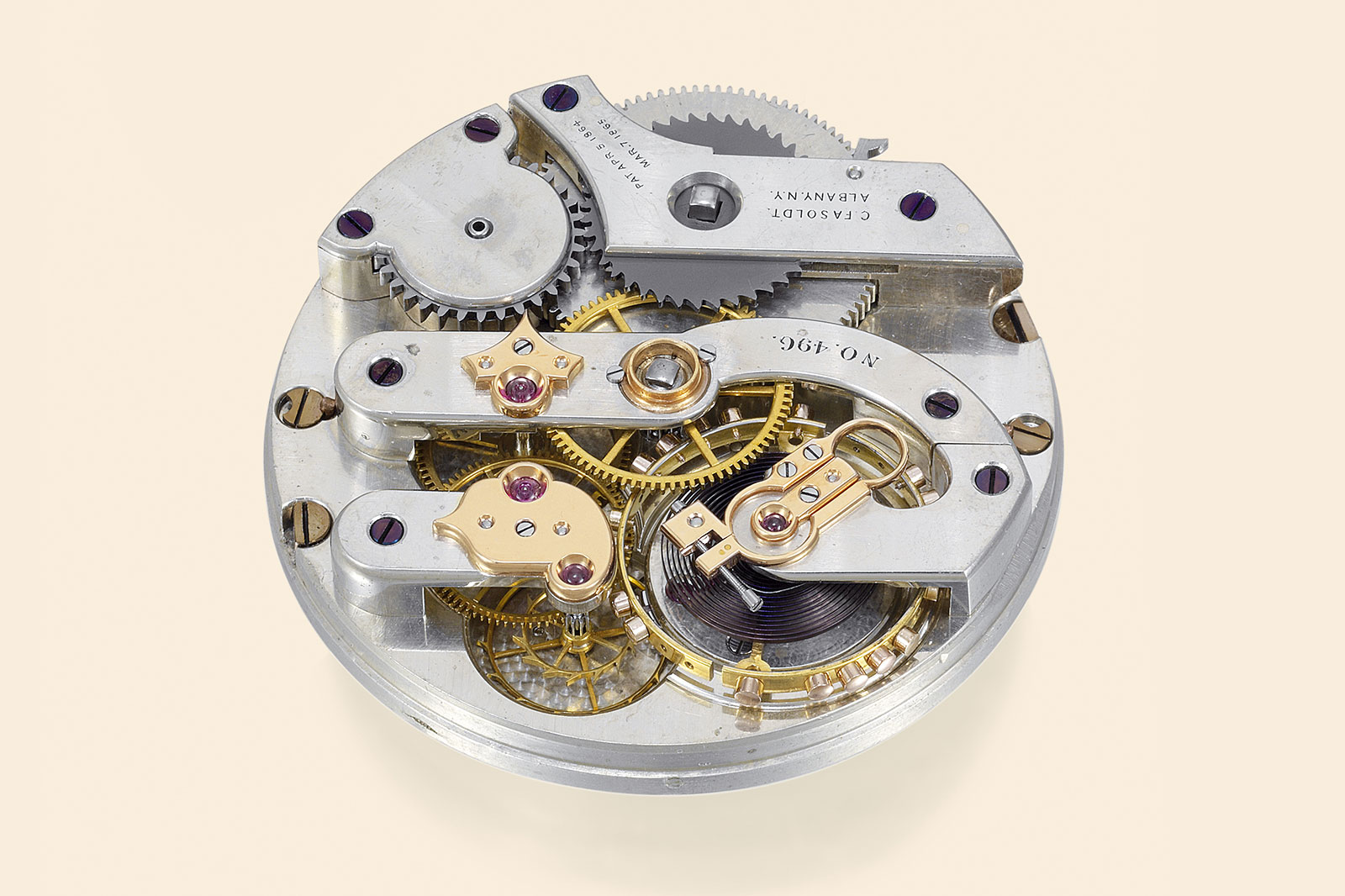
The movement of Charles Fasoldt pocket watch no. 496 dating to 1870; the watch was sold at Antiquorum in 2007. Image – Antiquorum
The co-axial
Having had the opportunity to have examine and restore several of the greatest timepieces in history, Daniels acquired an extensive knowledge of past masters’ works, perhaps to a greater degree than anyone before him. His first book, unassumingly titled Watches, contains part of that knowledge and serves as an excellent and detailed historical chronicle of pocket watches.
It includes a chapter concerning the evolution of the escapement that explains in detail each major historical escapement. A short paragraph covers the Fasoldt escapement, accompanied by a photo presumably taken by Daniels himself (he was known to be an amateur photographer who favoured Leica cameras).
Daniels describes the Fasoldt escapement as “an interesting and rarely seen variant of the lever escapement”. He points how the pallets’ action presents some similarity to that of the Robin escapement and adds “the inertia losses in the escapement are high and the action is correspondingly weak” without explaining the reasoning behind this observation.
In summing up the Fasoldt escapement, Daniels wrote, ‘The watches are beautifully made and were a brave if undistinguished attempt to introduce a little variety into escapements which, by that time, had inevitably settled into a pattern of dull uniformity.” While short and lacking in detail, the conclusion provides us with some insight into his impression of Fasoldt’s work.
His ambiguous claim about inertia losses may stem from practical experience he had with a pocket watch fitted with such an escapement; perhaps he noticed the abnormally large lift angle or the somewhat bulky lever. But he did not mention that the escapement was designed to run dry in the same way a detent escapement was. Overall, his commentary on the Fasoldt escapement suggested Daniels didn’t think much of it. Crucially, it proves Daniels was familiar with Fasoldt’s work, despite him considering it to be less than perfect.
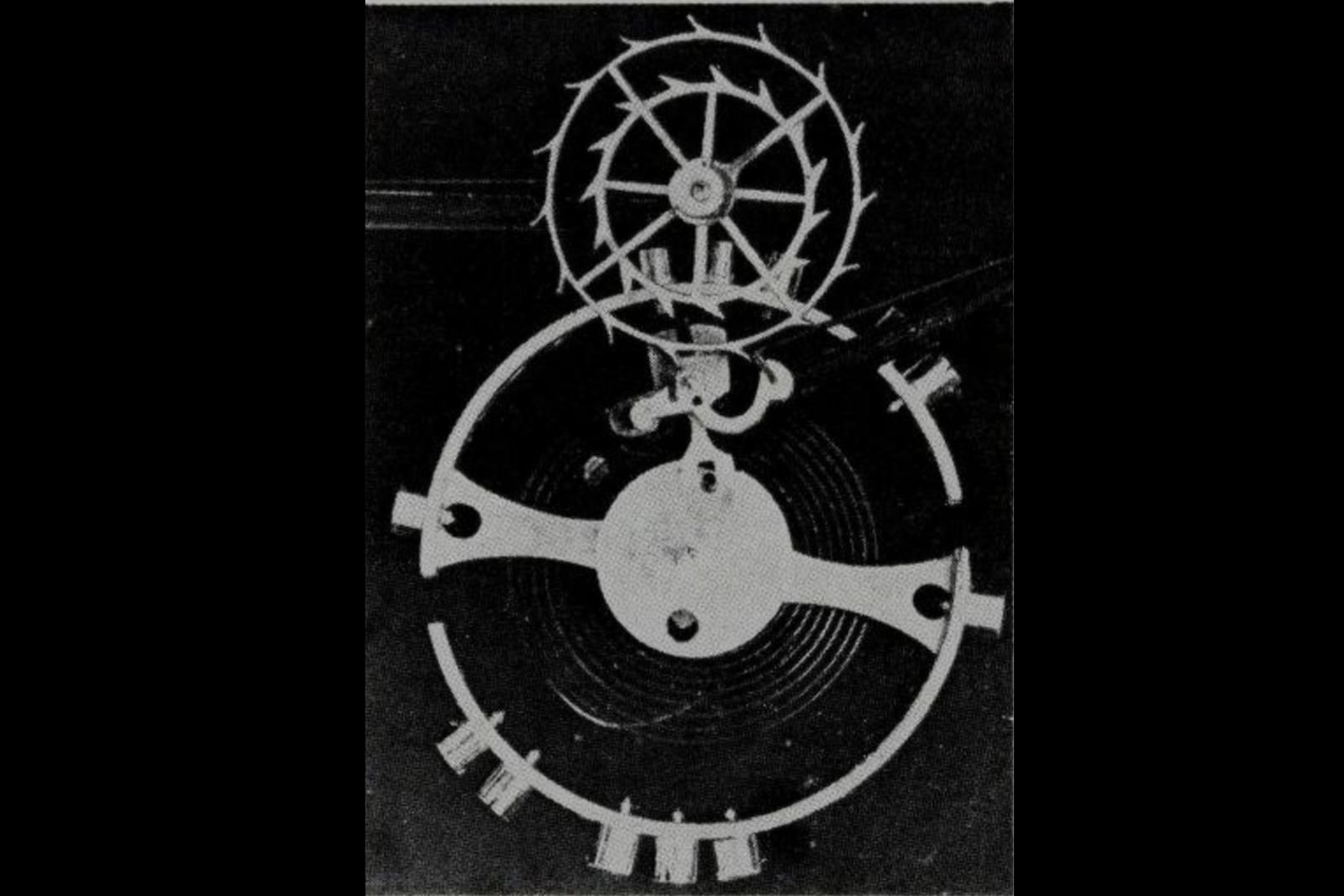
Fig. 4: Plate from Watches featuring the Fasoldt chronometer escapement. Image – Reproduction of plate 65, Watches (New York: Viking Press, 1965), George Daniels, Cecil Clutton
No doubt some years passed between Daniels’ first encounter with the Fasoldt escapement and the early 1970s when he perfected the co-axial escapement, fulfilling his ambition of creating a perfect escapement after much tweaking and prototyping. Daniels installed the escapement in several Swiss movements, from basic Omega time-only movements to tourbillons and even the Zenith El Primero chronograph. It proved reliable regardless of movement size, frequency, or complications.
With that, he attempted to persuade several major Swiss brands to adopt the co-axial escapement by demonstrating its performance and superiority to the Swiss lever across a range of movements. He met with little luck until the late Nicolas G. Hayek acquired the co-axial escapement for Omega. It took several more years for his dream of industrialising the co-axial to be realised, when in 1999 the first Omega watches equipped with the co-axial were launched.
One attribute that makes the co-axial escapement great is the way it combines all of Daniels’ requirements for an ideal escapement, one that can in theory surpass the Swiss lever he so despised, namely operating with minimal friction so it could go lubricant-free, to be self-starting, and to be reasonably easy to produce on a large scale. To that end, the co-axial makes use of a mixed-impulse system: one impulse is given directly to the balance wheel, while the other is delivered indirectly through a lever.
In summary, the co-axial can be thought of as a Swiss lever escapement at its base, with two standard pallets for locking and unlocking. However, instead of using the two standard pallets to transmit impulses to power the balance, it instead uses two additional pallets – one on a third arm of the escape lever, and one on the balance wheel arbour. These two additional pallets allow for a cleaner tangential impulse, minimising the effect of sliding friction. And ultimately this results in a design reminiscent to Fasoldt’s escapement.
Explaining co-axial’s operation should be considerably easier now since I already covered the Fasoldt in detail. The co-axial can be seen as a combination of the direct-impulse double-wheel and Fasoldt escapements, but bearing a closer resemblance to the latter.
While the co-axial does evoke the Fasoldt, Daniels did some extensive and remarkable work concerning the geometry and arrangement of the co-axial escapement. In the Fasoldt escapement, the centre of the escape wheel, the fulcrum of the lever, and the centre of the balance wheel all sit on the same line. This particular arrangement means the Fasoldt an “in-line” escapement, a trait it shares with the Swiss lever.
In practice, it means that the escape wheel is situated far from the balance so there no way they can directly interact. This is where the genius of Daniels’ idea comes through: he brought the escape wheel and balance as close together as possible (arranged in the same way as in his double-wheel escapement) while moving the lever to the side. The centres of each component no longer sit on the same line, instead, they form the three points of a triangle.
The lever in the co-axial, while still retaining three pallets fitted radially around the fulcrum, is different from that in the Fasoldt. Its fork (the part that interacts with the balance roller pin) is positioned near to the entry pallet. The same engineering choice can be found in some Swiss lever escapements with tourbillons, but that is done to save space. In the co-axial, the choice was made to facilitate contact between the two pallets seated equidistant from the fulcrum. This means that each interaction of the pallets with the escape wheel is equal, allowing the escape wheel to travel an identical distance of one tooth between each unlocking and locking.
The major innovation of the co-axial is the extra function performed by the lower escape wheel, which now provides direct impulse to the balance in addition to its locking function. As previously discussed, direct impulse can only occur between a balance and escape wheel moving in opposing directions. Combine that with the Fasoldt-inspired lever impulse phase and the result is a double-impulse escapement relying on just one escape wheel. This is precisely where the magic of the co-axial lies, a friction-free double impulse with just one escape wheel.
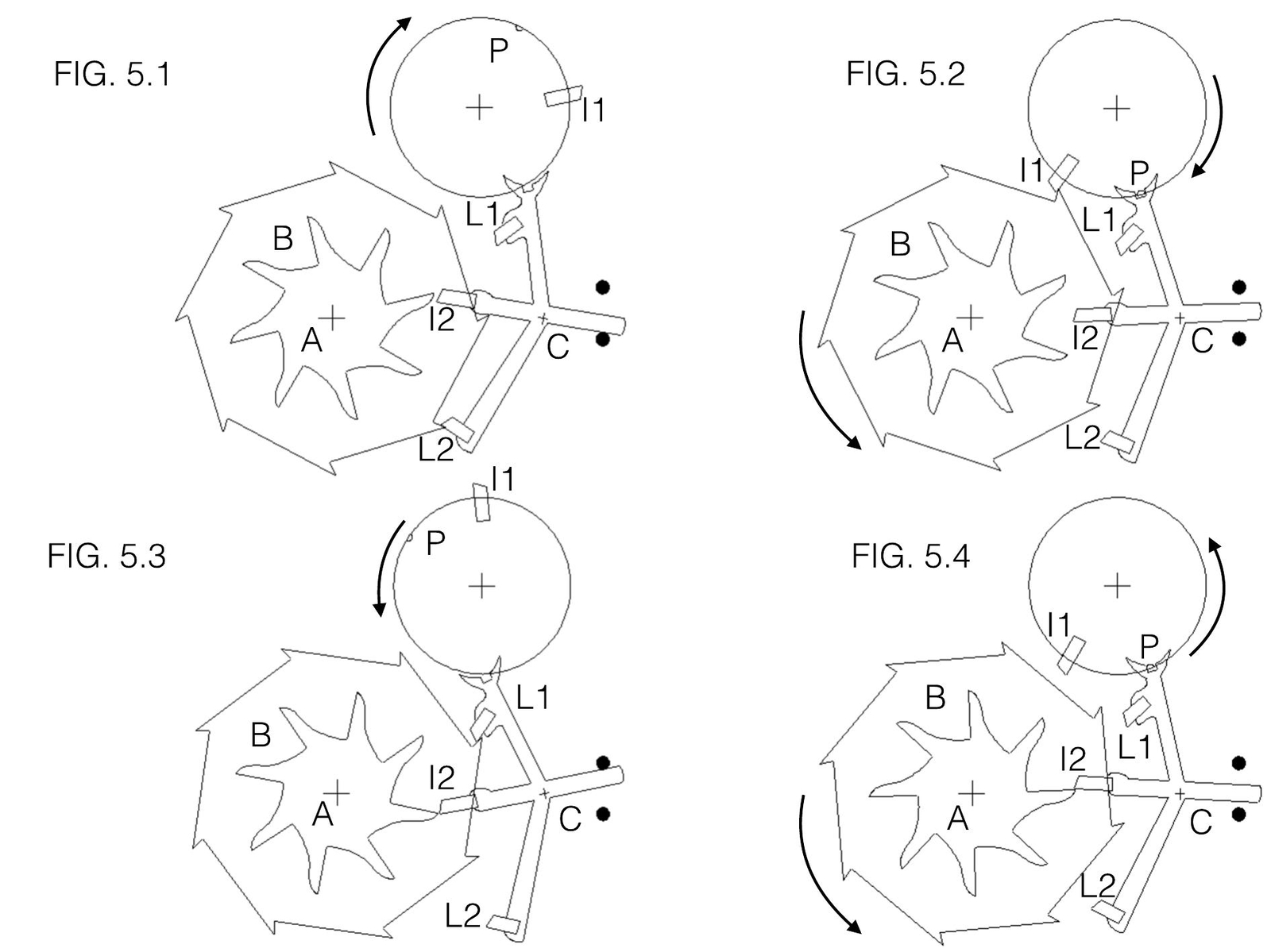
Fig. 5: Co-axial escapement stages. Image – abbeyclock.com
The co-axial (fig. 5) bears some resemblance to both the double-wheel and Fasoldt escapements in both form and function. But the co-axial escapement has two escape wheels with fewer teeth than those in the Fasoldt escapement. This stems from the double impulse nature of the co-axial, which means the impulsing action is split equally between the upper and lover escape wheels.
A step-by-step explanation of the co-axial escapement’s operation is as follows:
In fig. 5.1, the balance wheel begins turning back after the hairspring’s resisting force overcomes the impulse from the escapement. The escape wheels are locked by pallet L2 of lever C, which acts on wheel B. When the balance wheel returns toward its equilibrium point, the pin P engages lever C by making contact with its fork.
Pallet L2 disengages from wheel B, which promptly rotates and one of its teeth makes tangential contact with impulse pallet I1. Having completed an impulsing phase, the two-layer escape wheel comes to a stop when L1 locks one of its teeth (as shown in fig. 5.3). Again, the balance wheel begins to swing back, coerced by the hairspring. When the roller pin P engages the lever C, the escape wheel gets unlocked and the impulsing wheel A acts upon pallet I2, pushing the lever C, which in turn delivers the impulse to the balance through pin P.
Importantly, the co-axial is self-starting by design. When the mainspring runs down, the balance wheel settles in an equilibrium position, centred by the hairspring. In its equilibrium position, the balance half-engages the lever, which only faintly locks the escape wheel. If the watch is wound, the escape wheel will press upon either of the impulse pallets (I1 or I2, depending on the position), disturbing the balance’s equilibrium state and generating a small oscillation. That would cause a complete engagement or disengagement of the lever, thus starting an oscillating cycle.
In summary, the indirect impulse as well as the locking and unlocking phases of the co-axial escapement are in many ways borrowed from the Fasoldt escapement, while the direct impulse phase of the co-axial is identical to that in double-wheel escapement.
Interestingly, the very name of the co-axial escapement also refers back to the Fasoldt. The co-axial gets its name of the twin, stacked escape wheels in the original iteration of the escapement, a feature it shares with the Fasoldt. On the other hand, current iterations of the co-axial offered by Roger W. Smith in his watches only have a single escape wheel with two layers of teeth, making the co-axial moniker somewhat inaccurate.
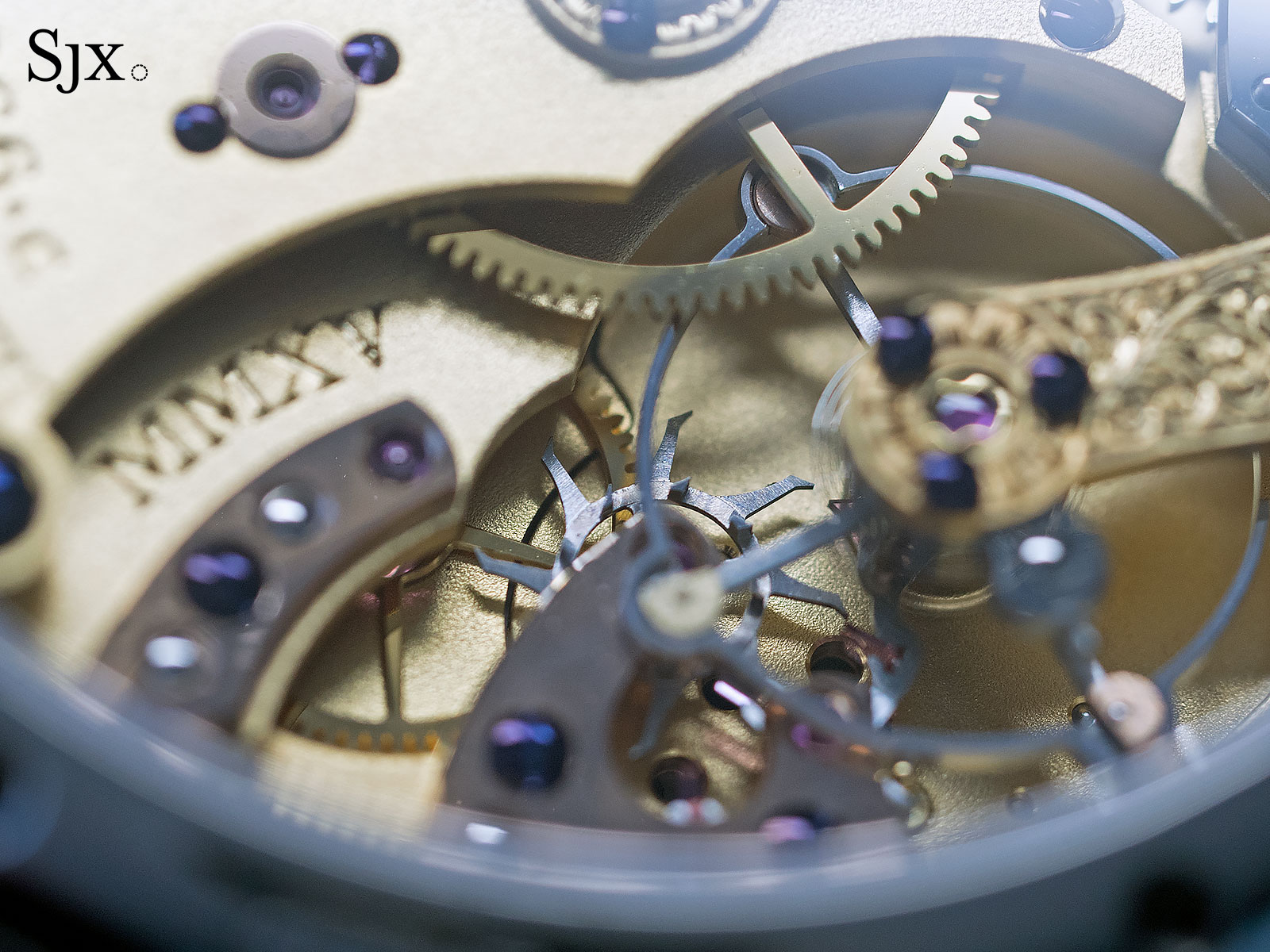
A recent iteration of the co-axial escapement as seen in a 2015 Roger W. Smith Series 2, revealing its single escape wheel
Parting thoughts
Analysing the double-wheel and co-axial escapements of Daniels as well as the Fasoldt escapement makes it likely the co-axial is an evolutionary hybrid of the other two.
In his memoir, All in Good Time: Reflections of a Watchmaker, Daniels recollects the patent office citing three patents against the one he filed for the co-axial, namely the Robin escapement, the double mixed-impulse Robin escapement (a Breguet design), and the Fasoldt chronometer escapement. That implies that even the non-specialists at patent office noticed the resemblance of the co-axial to the much older Fasoldt. Yet, except for the escape wheel and curious lever design, there is nothing else that links the two designs. Their respective execution and operation are remarkably different.
Today the co-axial is widely hailed as an a paragon of chronometry and reliability, thanks in large part to Omega’s massive marketing machine. It is irrefutable that Daniels devoted a great portion of his career to perfecting both the theoretical and practical aspects of co-axial escapement. He endured much trial and error until he deemed it satisfactory.
And the Fasoldt escapement was not perfect at all, with its large lift angle that interferes with the balance’s natural oscillation for longer than desired. And since it was a single impulse escapement, Fasoldt operates with a “lost beat”that robs the balance of its momentum while not providing any impulse in return. The co-axial, on the other hand, has a 36° lift angle and an 18° lever angle (due to the 2:1 lever to balance circumference ratio that Daniels deemed ideal), which keep inertial losses to a minimum.
Even Daniels’ earlier double-wheel escapement had its faults, mainly the need for a secondary gear train, perhaps explaining why he developed it no further. The co-axial is just as accurate and precise as the double-wheel, but runs on a single gear train, which makes it infinitely more practical in terms of manufacturing.
The ultimate conclusion to be drawn is the co-axial escapement was not merely the brainchild of one brilliant watchmaker, but an invention built on the ideas of historical greats, including Robert Robin, Abraham-Louis Breguet, and of course Charles Fasoldt.
A longtime watch enthusiast, the author is currently studying mathematics and physics, and plans to continue his studies in micro-engineering at Ecole Polytechnique Fédérale de Lausanne (EPFL).
Back to top.





